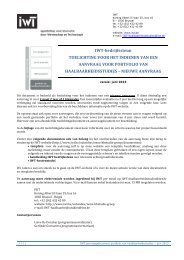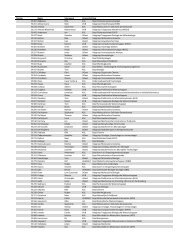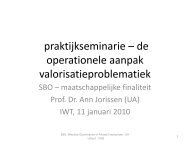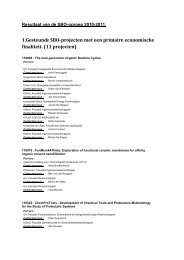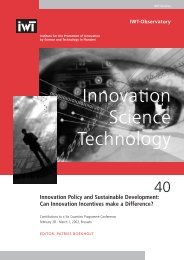The Evaluation of 'Behavioural Additionality' - IWT
The Evaluation of 'Behavioural Additionality' - IWT
The Evaluation of 'Behavioural Additionality' - IWT
You also want an ePaper? Increase the reach of your titles
YUMPU automatically turns print PDFs into web optimized ePapers that Google loves.
CHAPTER 3 > Conceptual and Empirical Challenges <strong>of</strong> Evaluating the Effectiveness <strong>of</strong><br />
Innovation Policies with ‘Behavioural Additionality’ .<br />
But the <strong>of</strong>ficial adoption <strong>of</strong> the ‘3% target’<br />
will be a leverage to build more ‘strategic<br />
intelligence’ for policy making, starting from<br />
monitoring and evaluation. <strong>The</strong> coordination<br />
<strong>of</strong> efforts to promote R&D with the federal<br />
government, that still is competent for fiscal<br />
instruments to stimulate R&D, is another<br />
incentive to assess more systematically the<br />
composition <strong>of</strong> the policy mix and <strong>of</strong> the<br />
innovation system from a strategic viewpoint.<br />
In particular strategic research has to orient<br />
towards the kind <strong>of</strong> knowledge economy<br />
that has to be constructed for maintaining<br />
the welfare position. Guidance for strategic<br />
evaluation on choices to be made is not<br />
explicitly formulated yet, but without this,<br />
implicit preferences and priorities shape the<br />
agenda. <strong>The</strong>refore the question <strong>of</strong> evaluation<br />
has to be linked with explicit analysis <strong>of</strong> the<br />
innovation system and the role <strong>of</strong> government<br />
in improving performance.<br />
<strong>Evaluation</strong> practices in Flanders at this<br />
moment are rather piecemeal and pragmatic,<br />
e.g. evaluation <strong>of</strong> the public research<br />
institutes or the evaluation <strong>of</strong> instruments<br />
within their own organisational boundaries.<br />
<strong>The</strong>y have a fragmented, organisationally<br />
narrow perspective and lack a firm theoretical<br />
basis. <strong>The</strong> bottom-up character <strong>of</strong> policies<br />
does not necessarily cause this, because<br />
also project evaluation can be put in a<br />
broader framework. But the stated policy<br />
objectives (promoting innovation for SMEs;<br />
promoting cooperation between actors and<br />
technology transfer from research institutes<br />
in particular; promoting environmental<br />
technology) are topical and not positioned<br />
on a global evaluation scale <strong>of</strong> the performance<br />
<strong>of</strong> the innovation system and the strategy<br />
<strong>of</strong> government. <strong>The</strong>refore the formal<br />
selection criteria that try to embody these policy<br />
objectives in stimulation programmes and<br />
projects can only partly cover the issues <strong>of</strong><br />
innovation performance on system level. A<br />
broader evaluation approach is needed.<br />
2.2. THE NEW PERSPECTIVE OF GOVER-<br />
NMENT ON INNOVATION<br />
Because <strong>of</strong> the limitations <strong>of</strong> actual evaluation<br />
practices it is <strong>of</strong> great importance to<br />
have a broader view on the behaviour <strong>of</strong><br />
innovation actors in the perspective <strong>of</strong> the<br />
innovation system, for the evaluation <strong>of</strong> the<br />
success <strong>of</strong> policy instruments, be it on project,<br />
programme or overall policy levels.<br />
First, just because there is more than what is<br />
captured by the stated policy objectives.<br />
More in particular, the effects <strong>of</strong> policies have<br />
to be considered as the result <strong>of</strong> an interaction<br />
between public strategies on the one<br />
hand and private strategies on the other;<br />
companies responding from their own point<br />
<strong>of</strong> view to the incentives <strong>of</strong> public instruments.<br />
Different instruments also combine<br />
mutually through specific interactions (policy<br />
mix). <strong>The</strong>refore an ‘ex post’ evaluation <strong>of</strong> the<br />
global impact <strong>of</strong> government stimulation is<br />
needed that goes beyond a narrow (one<br />
organisation) incentive (one instrument) to<br />
effect (one objective) perspective. Policy<br />
instruments have to be evaluated as one<br />
among many variables that explain the performance<br />
<strong>of</strong> the targeted actors, and the<br />
same goes for the policy mix at the level <strong>of</strong><br />
the system performance as a whole. Does policy<br />
‘make a difference’ How to evaluate<br />
results <strong>of</strong> these interactions<br />
Second, the constrained nature <strong>of</strong> evaluation<br />
at project and actor level <strong>of</strong> a set <strong>of</strong> private<br />
intentions or results and related public<br />
objectives can obscure the broader range <strong>of</strong><br />
social returns. <strong>The</strong>se are not fully implied in<br />
the actual policy set-up. Innovation seldom<br />
is an individual activity but the result <strong>of</strong><br />
complex interactive processes. Policy development<br />
is just beginning to discover and<br />
explore the huge ‘reserves’ <strong>of</strong> productivity<br />
gains that are linked to the better operation<br />
<strong>of</strong> the linkages in the innovation system.<br />
Innovation policy has to manage the innovation<br />
system from the point <strong>of</strong> view <strong>of</strong> the<br />
social return; Flemish innovation policy in<br />
particular has to devise a strategy to<br />
enhance the performance <strong>of</strong> the national<br />
innovation system to secure welfare creation<br />
for its citizens. This role <strong>of</strong> government<br />
as provider <strong>of</strong> new kinds <strong>of</strong> (s<strong>of</strong>t) infrastructure<br />
for innovation actors has to be matched<br />
with appropriate evaluation models.<br />
<strong>The</strong> ambitions <strong>of</strong> evaluation policy are<br />
therefore closely linked with the apprecia-<br />
60



